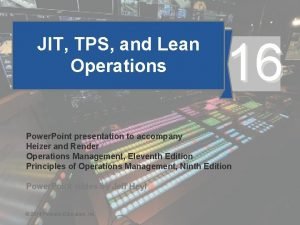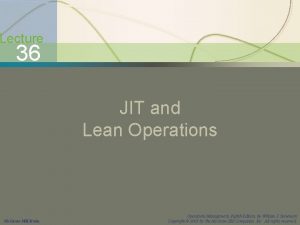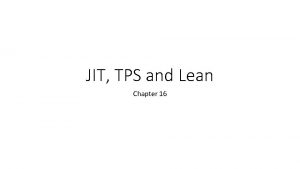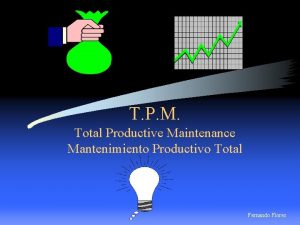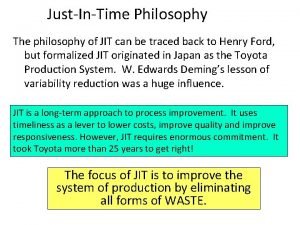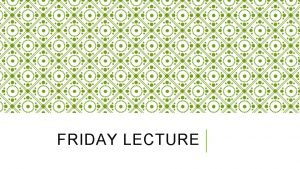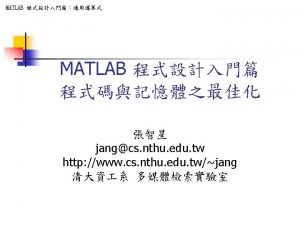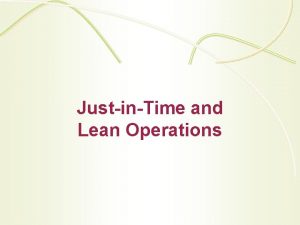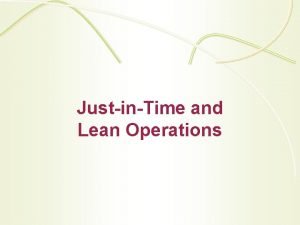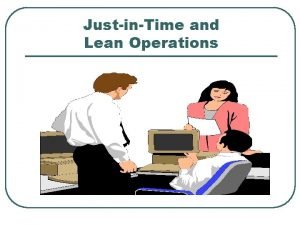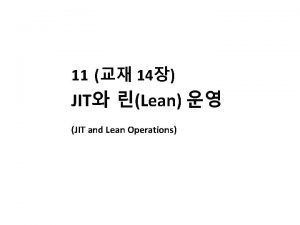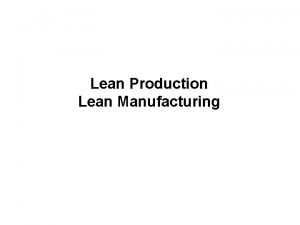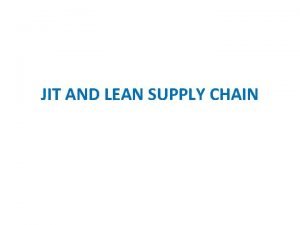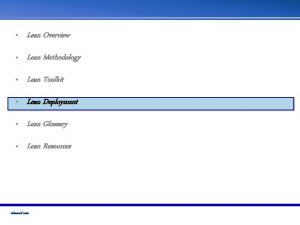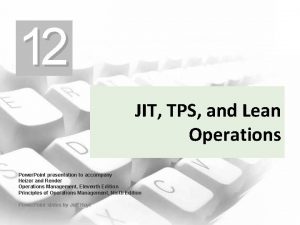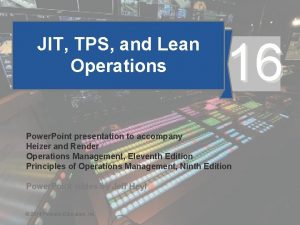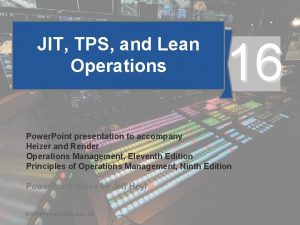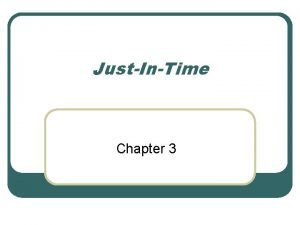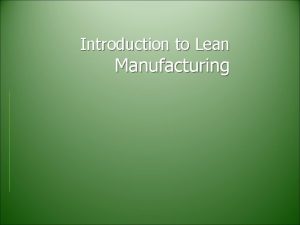JIT TPS and Lean Chapter 16 JIT TPS













- Slides: 13

JIT, TPS and Lean Chapter 16

JIT, TPS, Lean • The purpose of all these approaches is to eliminate waste, reduce variability, and improve throughput! • JIT (Just In Time) • Focus is on “forced problem solving” rather than covering it up • TPS (Toyota Production System) • Focus is on employee learning and empowerment • Lean • Focus is on understanding the customer and eliminating activities that don’t contribute value to them

Eliminate Waste • Waste is any activity that does not add value to the customer • Seven Categories of Waste Five Ss • • Overproduction Queues Transportation Inventory Motion Overprocessing Defects - Sort/Segregate - Simplify/Straighten - Shine/Sweep - Standardize - Sustain/Self-Discipline - *Safety - *Support

Remove Variability • Variation is any deviation (natural or artificial) from the optimum process that delivers the product on time every time. • It is often tolerated by management, but must not be! • Sources Include • Unknown Demand • Processes that allow employees to produce non-conforming units • Inaccurate drawings, incomplete product plans, specs • Variability may be “hidden”, by large inventories, etc

Improve Throughput • Throughput – rate at which goods move through a production process • “push” system – produces orders regardless of demand • “Pull” system – delivers material when and where it is needed • Both for suppliers and on factory floors • Uses signals to request when stations have capacity available • Pulls only the necessary amount

Just In Time (JIT) • Produce material when they are needed, where they are needed • If a unit doesn’t arrive, then it is a “problem” • Any problems become “visible” • No padding from inventory • No slack time

JIT Partnerships • Supplier and buyer collaborate to eliminate problems, unnecessary activities, inventory reduction, increase reliability • Scan in fig 16. 2

JIT Layout Tactics • Aim is to eliminate wasteful movement (goods, parts, people, etc) • Reduce distance • Work cell arrangement, etc • Increase Flexibility • Adapt to changes in volume, configuration, etc • Tactics with Employees • Cross-trained, communication of problems and feedback • Reduce space and inventory • Keep units moving downstream • Less need for storage space • Deliver to where goods are needed

JIT Inventory Tactics • Reduce inventory and lot sizes. • They can cover up problems, therefore it should be eliminated • Scan in fig 16. 3 and 16. 4 • Reduce setup costs • “one-touch” systems, training, materials, checklists, monitoring

JIT Scheduling Tactics • Communicate schedule to suppliers • Make level schedules • Frequent small batches as opposed to infrequent large • “freezing” the schedule close to delivery date • Kanban • Japanese word for “card” (but in reality could be a container, empty floor, etc) • Signal for demand from downstream to upstream • Scan in figure 16. 8

Quality Tactics • Measure! Use data collection and statistics to control processes • Empower employees • Build failsafe methods • Provide immediate feedback • Kaizen “change for the good” • Incremental changes • Standardize work processes

Quality Improvement with Six Sigma Define Control Improve Measure Analyze

How to build a “lean” organization • Use JIT tactics to eliminate inventory • Build systems to help employees produce perfect products • Reduce space requirements • Develop partnerships with suppliers • Educate suppliers about the end customer needs • Eliminate all but value added activities • Develop and challenge employees
 Jit tps and lean operations
Jit tps and lean operations Lean manufacturing and jit
Lean manufacturing and jit Jit tps
Jit tps Lean operational management
Lean operational management Jit and tqm
Jit and tqm Warp jit service
Warp jit service Son los programas de calidad jit, tqc, tpm, mrp
Son los programas de calidad jit, tqc, tpm, mrp Philosophy of jit
Philosophy of jit 15670t
15670t Elements of jit
Elements of jit Vectorizing matlab
Vectorizing matlab Characteristics of just-in-time partnerships do not include
Characteristics of just-in-time partnerships do not include Building blocks of jit
Building blocks of jit Braily
Braily
